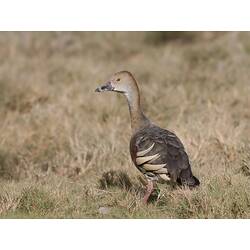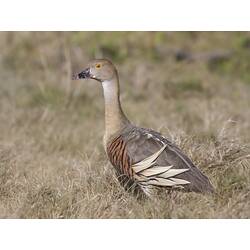General Description
A long-necked duck. Mostly yellowish brown, with black bars on rufous sides, and long pale yellow plumes edged with black protruding upwards from sides. Bill and legs pink. In flight, underwing brown, flecked on the leading half, yellow and brown on upperside. Wingbeats make a distinctive whistling sound. To 62 cm.
Biology
Occurs in pairs and flocks, from small numbers to many thousands. Congregates at permanent water during the dry season, dispersing to temporary wetlands during the wet. Grazes at night on grass and other plants on flats and the water's edge. Roosts by day on the shore. Breeds during the wet season. Probably mates for life. The nest is a depression on the ground, normally well away from water, amongst grass or other plants. 8-14 whitish eggs are laid.
Distribution
Northern and eastern Australia.
Habitat
Freshwater wetlands and nearby grasslands, and less commonly coastal wetlands.
More Information
-
Animal Type
-
Animal SubType
-
Brief Id
An elegant long-necked duck, mostly yellowish-brown with long pale yellow plumes protruding from its sides.
-
Colours
Brown
-
Maximum Size
62 cm
-
Habitats
-
Diet
Herbivore
-
Endemicity
-
Commercial
No
-
Conservation Statuses
CITES: Not listed, FFG Threatened List: Not listed, EPBC Act 1999: Not listed, IUCN Red List: Least Concern
-
Taxon Name
-
Common Name
Plumed Whistling Duck
-
Kingdom
-
Phylum
-
Subphylum
-
Class
-
Subclass
-
Order
-
Family
-
Subfamily
-
Genus
-
Species Name
eytoni




